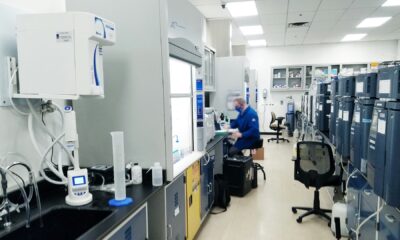Business
The Bank of Spain Concludes that European Funds Benefit SMEs more than Other Subsidies
Regarding the amounts received, large companies (more than 250 employees) receive larger subsidies: those granted to large companies present, according to the same text, amounts up to nine times greater than those of subsidies granted to companies with between 50 and 250 employees. Even so, in terms of amounts granted, the distribution of subsidies is more concentrated in small ones.

The Bank of Spain has prepared a preliminary study in which it concludes that the companies that have received subsidies from European Next Generation funds – which the European Commission created to promote the exit of the Twenty-seven from the coronavirus crisis – are above all small. The conclusion is that the beneficiaries of these funds are below the average size of the companies that usually receive subsidies of this type, according to the document, which also stops to separately analyze the characteristics of the companies awarded tenders.
“Companies that benefit from NGEU subsidies are, in general terms, smaller than companies that benefit from other public subsidies,” notes the document A first characterization of companies receiving NGEU funds in Spain, published this Thursday. On average, grant recipients have 17 employees (small businesses are those with between 10 and 50 employees).
“In the group of beneficiaries of NGEU subsidies there is a greater concentration of companies with between 10 and 50 employees than that of non-beneficiary entities and that of entities beneficiary of non-NGEU subsidies [other subsidies from funds that are not Next Generation] “. “Thus, approximately 55% of the companies that benefit from NGEU subsidies have less than 10 employees,” the text also highlights, highlighting that in general, companies that do not receive subsidies have that level of employees in 80% of the cases.
Read more about Bank of Spain and find the latest financial news of the day with the Born2Invest mobile app.
40% of the total is concentrated in companies with between 10 and 50 workers
Regarding the amounts received, large companies (more than 250 employees) receive larger subsidies: those granted to large companies present, according to the same text, amounts up to nine times greater than those of subsidies granted to companies with a between 50 and 250 employees. Even so, in terms of amounts granted, the distribution of subsidies is more concentrated in small ones : “About 40% of the total amount awarded in NGEU subsidies is concentrated in companies with between 10 and 50 employees, in contrast to approximately 25% of the total amount awarded in non-NGEU grants.”
The document also concludes that companies benefiting from Next Generation subsidies are up to 26% smaller than beneficiaries of other types of subsidies. And it shows that the companies receiving the former have greater productivity, age, better net worth, pay lower interest rates and present greater resilience.
“The results show that the business size of companies benefiting from NGEU subsidies is 26% smaller than that of beneficiaries of other subsidies, even after controlling for other characteristics of the companies that determine their size.” And this is not only due to programs like the Digital Kit, especially aimed at small companies: “It is a more generalized phenomenon,” the authors clarify.
The tenders are awarded to companies with 60 employees says Bank of Spain
On the other hand, on the tender side, the supervisor observes that the aforementioned European funds finance larger projects than in previous tenders, with an average amount of almost one million euros, compared to 73,000 in previous calls. In this area, tenders are concentrated in sectors such as construction, information and communication and commerce, and in this case the awarded companies are larger than those that are not awarded.
But they are not very large companies either: “The average size of NGEU companies is 57 employees, compared to the size of 15 and 52 employees for non-awarded and non-NGEU awarded companies, respectively.” However, the companies that are usually awarded tenders have an average size of 250 employees. In the same way as in the case of subsidies, the successful bidders also have greater productivity , greater net worth, a lower interest rate on their bank loans and a greater degree of resilience during the pandemic.
However, the Bank of Spain recommends that the Government develop specific tools to calibrate the macroeconomic effects of the funds: “The quantification of the macroeconomic impact of the NGEU program and the criteria for allocating funds between companies requires the development of modeling tools that allow their aggregate effects to be calibrated in dynamic terms.
Furthermore, advancing in the identification of the effects that the receipt of NGEU funds is having on the investment and growth of Spanish companies, as the necessary information becomes available, constitutes an objective In any case, it is worth highlighting that the long-term impact of the NGEU program will depend, fundamentally, on the transformative capacity of the selected investment projects and their complementarity with the structural reforms implemented, both aspects on which there is still no information. of the information necessary to carry out a rigorous study, but which will be the subject of priority analysis in the future for the Bank of Spain and for the Ministry of Economy, Commerce and Business.”
__
(Featured image by iphotoklick via Pixabay)
DISCLAIMER: This article was written by a third party contributor and does not reflect the opinion of Born2Invest, its management, staff or its associates. Please review our disclaimer for more information.
This article may include forward-looking statements. These forward-looking statements generally are identified by the words “believe,” “project,” “estimate,” “become,” “plan,” “will,” and similar expressions. These forward-looking statements involve known and unknown risks as well as uncertainties, including those discussed in the following cautionary statements and elsewhere in this article and on this site. Although the Company may believe that its expectations are based on reasonable assumptions, the actual results that the Company may achieve may differ materially from any forward-looking statements, which reflect the opinions of the management of the Company only as of the date hereof. Additionally, please make sure to read these important disclosures.
First published in EL INDEPENDIENTE, a third-party contributor translated and adapted the article from the original. In case of discrepancy, the original will prevail.
Although we made reasonable efforts to provide accurate translations, some parts may be incorrect. Born2Invest assumes no responsibility for errors, omissions or ambiguities in the translations provided on this website. Any person or entity relying on translated content does so at their own risk. Born2Invest is not responsible for losses caused by such reliance on the accuracy or reliability of translated information. If you wish to report an error or inaccuracy in the translation, we encourage you to contact us

-

 Biotech2 weeks ago
Biotech2 weeks agoVytrus Biotech Increases Its Sales by 32% in the First Quarter of 2024
-

 Cannabis5 days ago
Cannabis5 days agoPortugal Exports 99.85% of its Medical Cannabis, Selling only 17 Kg on the Local Market
-

 Crypto2 weeks ago
Crypto2 weeks agoSolana Rolls Out First Update to Address the Problem of Failed Transactions
-

 Crowdfunding2 days ago
Crowdfunding2 days agoThe French Real Estate Crowdfunding is Going through First Crisis

























